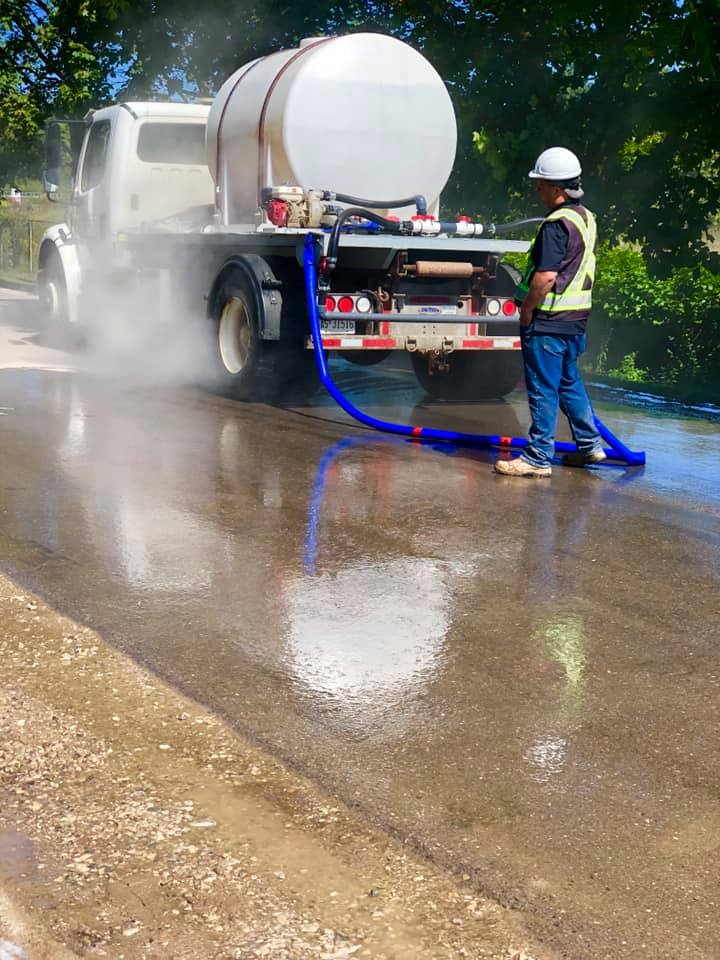Lignosulfonate, a natural byproduct of the wood pulping process, is a versatile and environmentally friendly option for controlling dust on unpaved roads, construction sites, mining haul roads, and other dusty environments. Derived from lignin, a complex polymer found in plant cell walls, lignosulfonate is widely used due to its adhesive properties, affordability, and minimal environmental impact.
What is Lignosulfonate and How Does It Work?
Lignosulfonate is a natural, water-soluble compound produced during the sulfite pulping process, where wood is broken down to extract cellulose for paper production. The resulting lignosulfonate is a sticky, high-viscosity liquid or powder that can be diluted with water for use as a dust suppressant. It comes in various forms, such as sodium, calcium, magnesium, or ammonium lignosulfonate, each with similar dust control properties but slight differences in solubility and environmental impact.
When applied to a road or dusty surface, lignosulfonate works in two primary ways:
- Binding Particles: The sticky nature of lignosulfonate acts like glue, binding fine dust particles and larger aggregates (like gravel or sand) together. As the water in the solution evaporates, it leaves behind a tacky film that holds the surface together, preventing dust from becoming airborne due to wind or vehicle traffic.
- Moisture Retention: Lignosulfonate is hygroscopic, meaning it attracts and retains moisture from the air. This keeps the treated surface slightly damp, further reducing dust generation. In some cases, exposure to sunlight can make lignosulfonate less soluble, forming a semi-durable crust that resists erosion.
This dual action makes lignosulfonate particularly effective for controlling dust in dry, arid climates or on roads with fine-grained materials like sand or silt. It’s commonly used on rural roads, logging roads, mining operations, agricultural fields, and construction sites.
Application Methods for Lignosulfonate
Lignosulfonate is typically applied as a liquid solution, diluted with water to a concentration of 20–30%. The application process depends on the desired outcome—dust suppression or road stabilization—and the condition of the surface. Here’s how it’s typically applied:
- Topical Application:
- Process: Lignosulfonate is sprayed onto the road surface using water trucks, tankers, or specialized sprayers. A common application rate is 0.3–0.5 gallons per square yard, though this varies based on road material and traffic volume.
- Preparation: For best results, the road should be pre-wetted to help the solution penetrate deeper into the surface. However, lignosulfonate can be applied without pre-wetting, though results may be less consistent.
- Equipment: Standard water trucks with spray bars are sufficient. After application, the road is often rolled or compacted to enhance the binding effect.
- Use Case: Topical application is ideal for quick dust control on existing roads or temporary surfaces like construction sites.
- Mixed-In Application:
- Process: Lignosulfonate is mixed into the top 2–4 inches of the road base using a grader or pulverizer, followed by compaction. This method creates a more durable, stabilized surface that resists washboarding, potholes, and dust generation.
- Preparation: The road is graded to remove potholes and ensure a smooth, crowned surface for proper drainage. Mixing requires more equipment and labor than topical application.
- Use Case: Best for high-traffic roads or areas needing long-term stabilization, such as mining haul roads or permanent rural roads.
- Maintenance Applications:
- After initial application, lignosulfonate builds up in the road base over time, reducing the amount needed for subsequent treatments. Annual or semi-annual applications are common, depending on traffic, weather, and road conditions.
For optimal results, roads should be properly prepared by grading to remove ruts and potholes and ensuring a slight crown (2–4% slope) for drainage. While lignosulfonate can be applied to unprepared surfaces, this may reduce its effectiveness and longevity.
Benefits of Lignosulfonate for Dust Control
Lignosulfonate offers several advantages, making it a popular choice for dust control in various settings:
- Environmental Friendliness:
- Lignosulfonate is biodegradable and non-toxic to humans, animals, and aquatic life. It’s approved by the U.S. Environmental Protection Agency (EPA) for use near water bodies, orchards, and environmentally sensitive areas.
- It contains trace metals (e.g., calcium, magnesium) at levels well below EPA limits and has no detectable dioxins, making it safe for organic farming and other regulated areas.
- Sodium, calcium, magnesium, and ammonium lignosulfonates are permitted under the USDA National Organic Program (NOP) for dust suppression, though aluminum lignosulfonate is restricted due to potential environmental concerns.
- Cost-Effectiveness:
- Lignosulfonate is relatively inexpensive, with costs ranging from $0.5–2 per kilogram, depending on the supplier and form (liquid or powder). This is lower than many synthetic alternatives like polymers.
- Studies show it can reduce road maintenance costs by 42–61% compared to untreated roads by minimizing the need for frequent grading and gravel replacement.
- Over time, repeated applications reduce the amount of product needed, as lignosulfonate accumulates in the road base, enhancing long-term savings.
- Effective Dust Suppression:
- In optimal conditions (e.g., dry climates with sandy or gravel roads), lignosulfonate reduces dust by 70–90%, improving air quality, visibility, and safety for drivers and nearby communities.
- It’s particularly effective on roads with coarse materials like gravel or sand, where its adhesive properties create a stable surface.
- Versatility:
- Lignosulfonate is suitable for a wide range of applications, including rural roads, mining haul roads, construction sites, agricultural fields, and industrial material storage areas.
- It can be blended with other products (e.g., polymers or chlorides) to enhance performance for specific conditions, such as heavy traffic or fine dust.
- Improved Road Stability:
- When mixed into the road base, lignosulfonate strengthens the surface, reducing washboarding, potholes, and loose gravel. This leads to smoother, safer roads and lower maintenance needs.
Limitations of Lignosulfonate
While lignosulfonate is effective, it has some drawbacks that should be considered:
- Limited Durability:
- Lignosulfonate is water-soluble, so heavy rain or prolonged wet conditions can wash it away, requiring reapplication. It’s less durable than chloride-based suppressants like calcium or magnesium chloride.
- In high-traffic areas, the surface may break down faster, necessitating more frequent maintenance.
- Performance on Fine Dust:
- Lignosulfonate is less effective at controlling very fine dust particles (e.g., PM10, particles smaller than 10 micrometers). Studies show it reduces fine dust by about 20% compared to 90% for some synthetic polymers like polyvinyl acrylic.
- For roads with significant fine dust, blending lignosulfonate with polymers can improve performance.
- Aesthetic and Maintenance Issues:
- Freshly applied lignosulfonate is dark brown, which may be visually unappealing in some settings. The color fades with traffic and rain but can leave a sticky residue on vehicles or equipment.
- The residue can be cleaned with warm, soapy water, but this adds a maintenance step for equipment operators.
- Application Challenges:
- Proper application requires equipment like water trucks and, ideally, graders or rollers, which may not be available in remote or low-budget settings.
- Over-application can make roads slippery, while under-application reduces effectiveness.
Comparison to Other Dust Suppressants
Lignosulfonate is one of many dust control options, each with unique strengths and weaknesses. Here’s how it compares to common alternatives:
- Chloride-Based Suppressants (Calcium/Magnesium Chloride):
- Pros: More durable than lignosulfonate, especially in wet conditions, and effective at retaining moisture due to their hygroscopic nature.
- Cons: Corrosive to vehicles and equipment, potentially harmful to vegetation and groundwater, and less environmentally friendly. Lignosulfonate is a better choice for sandy roads or eco-sensitive areas.
- Cost: Comparable to lignosulfonate, but corrosion-related maintenance can increase long-term costs.
- Synthetic Polymers (e.g., Polyvinyl Acrylic):
- Pros: More effective at controlling fine dust (up to 90% reduction) and often longer-lasting than lignosulfonate.
- Cons: More expensive (2–3 times the cost of lignosulfonate) and less biodegradable, raising environmental concerns in sensitive areas.
- Use Case: Best for high-traffic roads or areas with significant fine dust, where lignosulfonate alone may underperform.
- Water:
- Pros: Readily available and inexpensive, making it a common choice for temporary dust control.
- Cons: Extremely short-lived (10–30 minutes in hot, dry climates), requiring frequent reapplication and high water use. Lignosulfonate is far more efficient for long-term dust control.
- Use Case: Suitable for very short-term needs or emergencies but impractical for sustained use.
- Asphalt or Oil-Based Products:
- Pros: Create a hard, durable surface that resists dust and wear.
- Cons: Expensive, non-biodegradable, and environmentally harmful due to potential runoff. Lignosulfonate is a greener, cheaper alternative for most unpaved roads.
Practical Tips for Using Lignosulfonate
To maximize the effectiveness of lignosulfonate for dust control, consider the following:
- Road Preparation:
- Grade the road to remove potholes, ruts, and loose material. A crowned surface (2–4% slope) ensures proper drainage, reducing washout in wet conditions.
- Pre-wet the road before application to improve penetration and binding.
- Application Timing:
- Apply during dry weather to allow the solution to penetrate and dry properly. Avoid application before heavy rain, as it may wash away.
- Spring or early summer applications are ideal in many climates, providing dust control through the dry season.
- Dosage and Frequency:
- Start with 0.3–0.5 gallons per square yard for topical applications. Adjust based on road material, traffic, and dust levels.
- Reapply annually or as needed, noting that repeated applications reduce the amount required over time as lignosulfonate accumulates in the road base.
- Blending for Enhanced Performance:
- For roads with fine dust or heavy traffic, consider products which combine lignosulfonate with polymers for improved dust control and durability.
- Supplier and Product Options:
- Suppliers like GREEN AGROCHEM offer tailored solutions and technical support.
- Contact suppliers for bulk pricing, delivery options, and guidance on application rates for specific road types.
- Environmental Compliance:
- Verify that the lignosulfonate product complies with local regulations, especially in organic farming or near water bodies. Sodium, calcium, and magnesium lignosulfonates are generally approved.
Real-World Applications and Case Studies
Lignosulfonate has been successfully used in various settings:
- Rural and Logging Roads: In regions like the Pacific Northwest, lignosulfonate stabilizes gravel roads, reducing dust and maintenance costs for logging operations.
- Mining Haul Roads: In arid areas like Arizona or Australia, lignosulfonate controls dust on heavy-duty haul roads, improving safety and reducing equipment wear.
- Construction Sites: Temporary roads at construction sites benefit from lignosulfonate’s quick application and environmental safety, especially near urban or sensitive areas.
- Agricultural Fields: Farmers use lignosulfonate to control dust on access roads and near orchards, where chemical runoff is a concern.
For example, a 2019 study on dust suppressants found lignosulfonate reduced dust by 70–80% on gravel roads in dry climates, with maintenance savings of up to 50% compared to untreated roads. Blending with polymers increased fine dust control to 85%, making it a cost-effective hybrid solution.
Conclusion and Recommendations
Lignosulfonate is an excellent choice for dust control on unpaved roads and other dusty surfaces, offering a balance of affordability, environmental safety, and effectiveness. Its ability to bind particles, retain moisture, and stabilize surfaces makes it ideal for rural roads, mining operations, and construction sites, particularly in dry climates or sandy soils. While it’s less durable than chlorides and less effective on fine dust compared to polymers, its low cost and eco-friendly profile make it a top contender for many applications.

